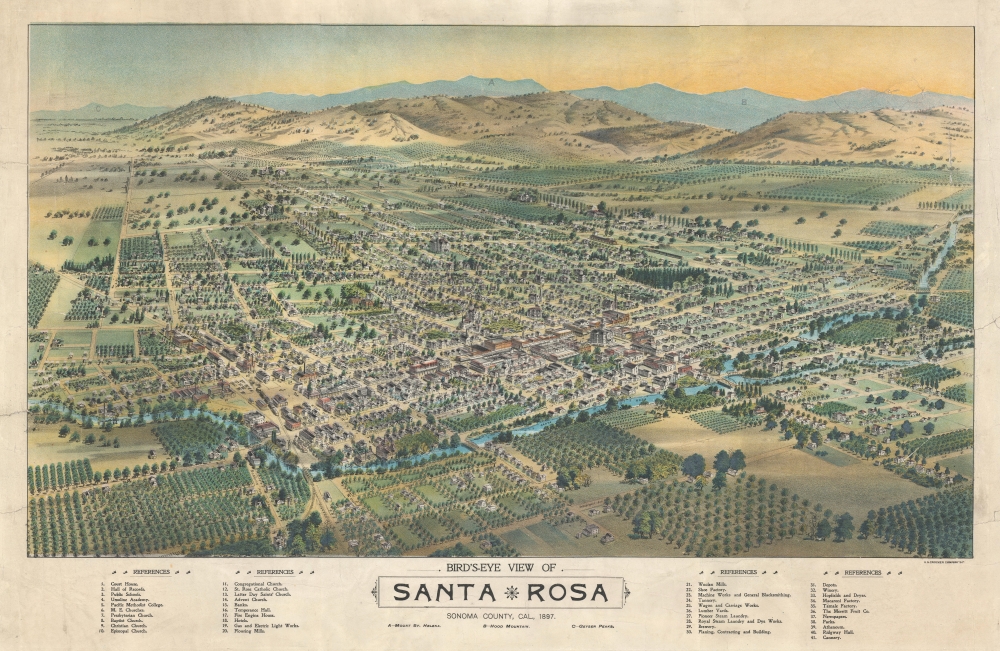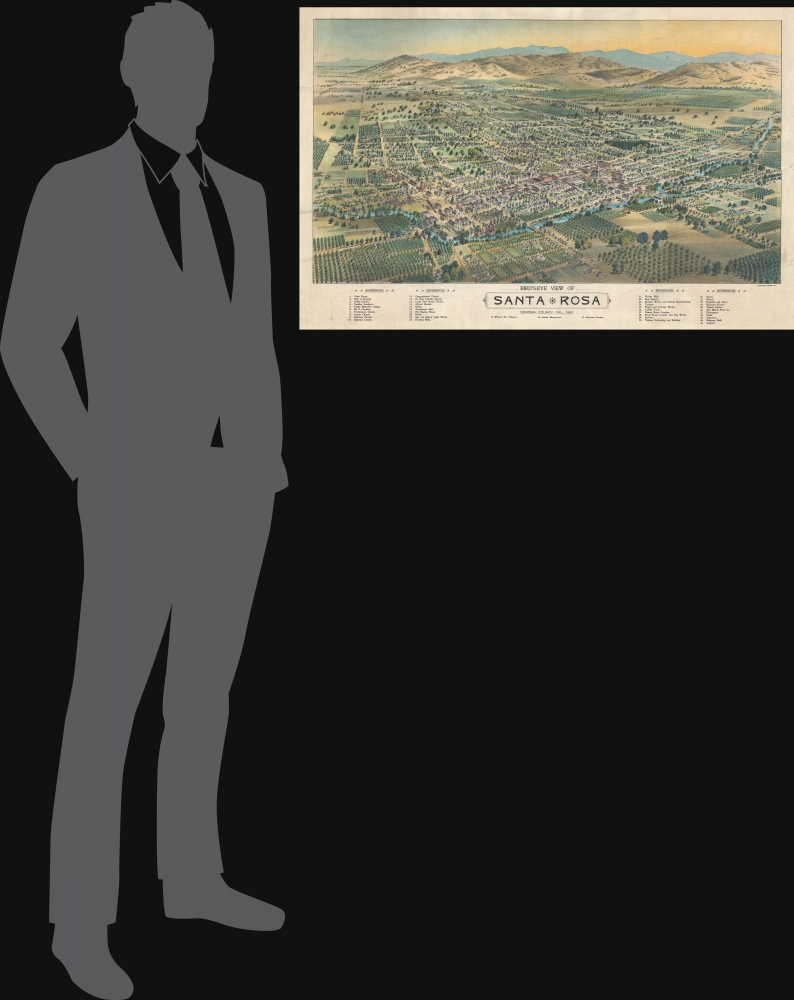1897 Crocker Chromolithograph View of Santa Rosa, California
SantaRosaCA-crocker-1897
Title
1897 (dated) 21 x 31.5 in (53.34 x 80.01 cm)
Description
A Closer Look
The view looks north on Santa Rosa from a high point south of town. Santa Rosa Creek dominates the foreground, the city's center fills the mid-ground, and Mount St. Helena, Hood Mountain, and the Geyer Peaks loom in the background. The view celebrates Santa Rosa as both as bustling cosmopolitan center and an agricultural community. Along the bottom of the map 41 businesses and churches are numerically keyed to locations on the view, ranging from factories, to wineries, printing houses, social clubs, fruit companies, and parks.Historical Context
In the late 1890s, Santa Rosa, and Sonoma in general, was emerging as the center of northern California agriculture and viticulture, laying the foundation for what would become the heart of California's wine country. As the county seat of Sonoma, Santa Rosa was a vibrant hub of economic activity and cultural life. As illustrated in this view, the completion of regional railroads spurred development, connecting Santa Rosa with larger markets and making the beautiful Sonoma region accessible to tourists and new residents. Santa Rosa distinctive mesh of Spanish colonial and Victorian architecture began to emerge around this time.American Bird's-Eye City Views
The Bird's-Eye view industry emerged in the United States in the middle part of the 19th century and coincided with the commercial development of lithographic printing. Before the rise of lithography, the ability to own and display artwork in the home was largely limited to the extremely wealthy, but the advent of lithographic printing made it possible for everyone to own visually striking artwork. A robust trade developed in portraits of political leaders, allegorical and religious images, and city views.City views were being produced in the United States as early as the 1830s, but the genre exploded after the American Civil War (1861 - 1865). Bridging the gap between maps and pictures, most 19th century American bird's-eye views presented cities to the public from highpoints. Some were imagined, but others were drawn from hot-air balloons or nearby hills. The presentation, combining high elevation, commercial interest, and new printing technology created a uniquely American artform, as described by historian Donald Karshan,
Some print connoisseurs believe that it was only with the advent of the full-blown city-view lithograph that American printmaking reached its first plateau of originality, making a historical contribution to the graphic arts. They cite the differences between the European city-view prints and the expansive American version that reflects a new land and a new attitude toward the land.The vogue for bird's-eye city views lasted from about 1845 to 1920, during which period some 2,400 cities were thus portrayed, some multiple times. Although views were produced in many urban centers, the nexus of view production in the United States was Milwaukee, Wisconsin. The major American viewmakers were Stoner, Wellge, Bailey, Fowler, Hill Ruger, Koch, Burleigh, Norris, and Morse, among others.
Chromolithography
Chromolithography, sometimes called oleography, is a color lithographic technique developed in the mid-19th century. The process uses multiple lithographic stones, one for each color, to yield a rich composite effect. Generally, a chromolithograph begins with a black basecoat upon which subsequent colors are layered. Some chromolithographs used 30 or more separate lithographic stones to achieve the desired effect. Chromolithograph color can be blended for even more dramatic results. The process became extremely popular in the late 19th and early 20th centuries when it emerged as the dominant method of color printing. The vivid color chromolithography made it exceptionally effective for advertising and propaganda.Publication History and Census
This view was issued by Henry S. Crocker, one of California's most prosperous printers. This view is not listed in Reps or OCLC. We see just one institutional holding, California State Library (1999-0158). We are aware of two being offered on the private market in the last 30 years, making this the 4th known example.Cartographer
Henry Smith Crocker (January 31, 1832 - July 18, 1904) was an American printer, publisher, and railroad investor active in northern California in the middle to late 19th century. Crocker followed the Gold Rush to California, settling in Sacramento in the 1850s. He established his printing concern, H. S. Crocker, in 1856. Apparently his first office was little more than a tent with a small sign. Crocker relocated to San Francisco in 1871. He became extremely wealthy almost overnight by leveraging his ties to the Central Pacific Railroad, which is brother, Charles Crocker (1822 - 1888) founded. In 1885, Crocker constructed a large five-story printing factory, powered by his own private steam plant, then the largest and most sophisticated printing concern on the west coast. Crocker's prosperity continued and by the time he died in 1904, he was the head of a large and wealthy family. Although Crocker passed on, his company, H.S. Crocker, continued to operate and remains active to this day. More by this mapmaker...




